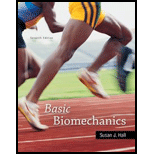
Basic Biomechanics
7th Edition
ISBN: 9780073522760
Author: Susan J Hall
Publisher: McGraw-Hill Education
expand_more
expand_more
format_list_bulleted
Concept explainers
Textbook Question
Chapter 14, Problem 3AP
A 0.68-kg tennis ball is given an angular momentum of 2.72 10−3 kg m2/s when struck by a racket. If its radius of gyration is 2 cm, what is its angular velocity? (Answer: 10 rad/s)
Expert Solution & Answer
Want to see the full answer?
Check out a sample textbook solution
Chapter 14 Solutions
Basic Biomechanics
Ch. 14 - If you had to design a model of the human body...Ch. 14 - Construct a table displaying common units of...Ch. 14 - Skilled performance of a number of sport skills is...Ch. 14 - Prob. 5IPCh. 14 - How much angular impulse must be supplied by the...Ch. 14 - Given the following principal transverse axis...Ch. 14 - A volleyball players 3.7-kg arm moves at an...Ch. 14 - A 50-kg diver in a full layout position, with a...Ch. 14 - Prob. 10IPCh. 14 - The radius of gyration of the thigh with respect...
Ch. 14 - A 0.68-kg tennis ball is given an angular momentum...Ch. 14 - A 7.27-kg shot makes seven complete revolutions...Ch. 14 - Prob. 5APCh. 14 - The patellar tendon attaches to the tibia at a 20...Ch. 14 - A cavewoman swings a 0.75-m sling of negligible...Ch. 14 - A 7.27-kg hammer on a 1-m wire is released with a...Ch. 14 - Discuss the effect of banking a curve on a...
Knowledge Booster
Learn more about
Need a deep-dive on the concept behind this application? Look no further. Learn more about this topic, bioengineering and related others by exploring similar questions and additional content below.Recommended textbooks for you
 Principles Of Radiographic Imaging: An Art And A ...Health & NutritionISBN:9781337711067Author:Richard R. Carlton, Arlene M. Adler, Vesna BalacPublisher:Cengage Learning
Principles Of Radiographic Imaging: An Art And A ...Health & NutritionISBN:9781337711067Author:Richard R. Carlton, Arlene M. Adler, Vesna BalacPublisher:Cengage Learning

Principles Of Radiographic Imaging: An Art And A ...
Health & Nutrition
ISBN:9781337711067
Author:Richard R. Carlton, Arlene M. Adler, Vesna Balac
Publisher:Cengage Learning





Chapter 7 - Human Movement Science; Author: Dr. Jeff Williams;https://www.youtube.com/watch?v=LlqElkn4PA4;License: Standard youtube license